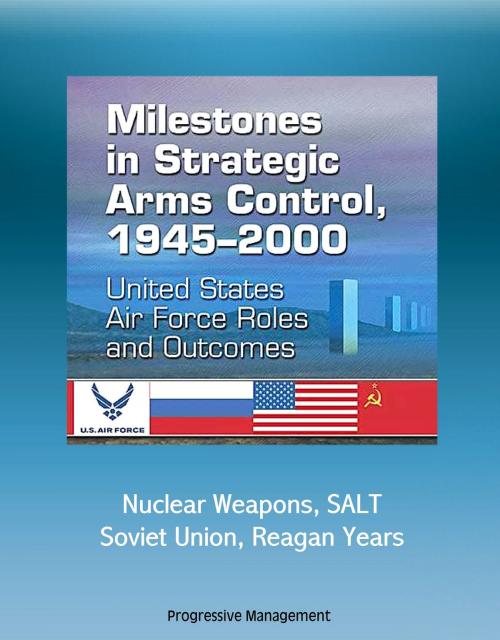Milestones in Strategic Arms Control, 1945-2000: United States Air Force Roles and Outcomes - Nuclear Weapons, SALT, Soviet Union, Reagan Years
Nonfiction, History, Military, Nuclear Warfare, Weapons| Author: | Progressive Management | ISBN: | 9781476354231 |
| Publisher: | Progressive Management | Publication: | June 26, 2012 |
| Imprint: | Smashwords Edition | Language: | English |
| Author: | Progressive Management |
| ISBN: | 9781476354231 |
| Publisher: | Progressive Management |
| Publication: | June 26, 2012 |
| Imprint: | Smashwords Edition |
| Language: | English |
Just over six decades ago, the United States was a nation trying to adhere to a largely isolationist outlook, the potential power of the atom was yet to be fully realized and had certainly not been weaponized, and the defense of our nation was entrusted to a secretary of war and a secretary of Navy. The many changes in the years since World War II have been spectacular and fundamental. There is a fascinating interconnectivity among at least three threads that run through that period. The role of nuclear weapons, the rise of an independent Air Force, and the shaping of national and international security through arms-control agreements have all had their most profound development in this time frame. The relation between the newly created Air Force in 1947 and the growing reliance by this country on nuclear weapons for deterrence and defense is a well-known story. The impetus that these nuclear devices gave to negotiations on arms control is also well-covered ground; although, of course, arms-control encompasses more than nuclear armaments. How about a third connection? Where has the Air Force been in the arms control arena? Is it a story of interest? I submit that it is an important story and the history of the United States Air Force is fundamentally incomplete without recounting how the junior service has shaped various arms treaties and been shaped by them.
This book is about arms control, so it is most appropriate to begin with a discussion of arms control as a construct within US national security policy during the Cold War and in its immediate aftermath. The classic description of arms control as a strategic policy construct remains that of Thomas Schelling and Morton Halperin in their seminal 1961 work, Strategy and Arms Control. We believe that arms control is a promising . . . enlargement of the scope of our military strategy. It rests essentially on the recognition that our military relation with potential enemies is not one of pure conflict and opposition, but involves strong elements of mutual interest in the avoidance of a war that neither side wants, in minimizing the costs and risks of the arms competition, and in curtailing the scope and violence of war in the event it occurs.
Contents * FOREWORD * INTRODUCTION * PART I * Foundations for Strategic Arms Control, 1945-68 * Chapter 1 * The United States Air Force and Arms Control: The Early Years * Michael O. Wheeler * Chapter 2 * Peace through Strength Alone: US Air Force Views on Arms Control in the 1950s and Early 1960s * Edward Kaplan * PART II * Strategic Arms Limitations, 1969-80 * Chapter 3 * The Road to SALT * Anne G. Campbell * Chapter 4 * Strategic Arms Control and the US Air Force: The SALT Era, 1969-80 * Jeffrey A. Larsen * PART III * The Reagan Years, 1981-88 * Chapter 5 * Arms Control during the Reagan Administration * Charles D. Dusch Jr. * Chapter 6 * National Security Strategy, Arms Control, and the US Air Force: The Reagan Years, 1981-88 * Forrest E. Waller Jr. * PART IV * Strategic Arms Reductions, 1989-2000 * Chapter 7 * Arms Control after the Cold War * Thomas S. Mowle * Chapter 8 * Downsizing and Shifting Operational Emphasis for the US Air Force: The Bush and Clinton Years, 1989-2000 * Thomas D. Miller * PART V * Conclusion * Chapter 9 * The USAF and Strategic Arms Control * Gwendolyn M. Hall * Contributors * Bibliographic Essay * Jeffrey A. Larsen
Just over six decades ago, the United States was a nation trying to adhere to a largely isolationist outlook, the potential power of the atom was yet to be fully realized and had certainly not been weaponized, and the defense of our nation was entrusted to a secretary of war and a secretary of Navy. The many changes in the years since World War II have been spectacular and fundamental. There is a fascinating interconnectivity among at least three threads that run through that period. The role of nuclear weapons, the rise of an independent Air Force, and the shaping of national and international security through arms-control agreements have all had their most profound development in this time frame. The relation between the newly created Air Force in 1947 and the growing reliance by this country on nuclear weapons for deterrence and defense is a well-known story. The impetus that these nuclear devices gave to negotiations on arms control is also well-covered ground; although, of course, arms-control encompasses more than nuclear armaments. How about a third connection? Where has the Air Force been in the arms control arena? Is it a story of interest? I submit that it is an important story and the history of the United States Air Force is fundamentally incomplete without recounting how the junior service has shaped various arms treaties and been shaped by them.
This book is about arms control, so it is most appropriate to begin with a discussion of arms control as a construct within US national security policy during the Cold War and in its immediate aftermath. The classic description of arms control as a strategic policy construct remains that of Thomas Schelling and Morton Halperin in their seminal 1961 work, Strategy and Arms Control. We believe that arms control is a promising . . . enlargement of the scope of our military strategy. It rests essentially on the recognition that our military relation with potential enemies is not one of pure conflict and opposition, but involves strong elements of mutual interest in the avoidance of a war that neither side wants, in minimizing the costs and risks of the arms competition, and in curtailing the scope and violence of war in the event it occurs.
Contents * FOREWORD * INTRODUCTION * PART I * Foundations for Strategic Arms Control, 1945-68 * Chapter 1 * The United States Air Force and Arms Control: The Early Years * Michael O. Wheeler * Chapter 2 * Peace through Strength Alone: US Air Force Views on Arms Control in the 1950s and Early 1960s * Edward Kaplan * PART II * Strategic Arms Limitations, 1969-80 * Chapter 3 * The Road to SALT * Anne G. Campbell * Chapter 4 * Strategic Arms Control and the US Air Force: The SALT Era, 1969-80 * Jeffrey A. Larsen * PART III * The Reagan Years, 1981-88 * Chapter 5 * Arms Control during the Reagan Administration * Charles D. Dusch Jr. * Chapter 6 * National Security Strategy, Arms Control, and the US Air Force: The Reagan Years, 1981-88 * Forrest E. Waller Jr. * PART IV * Strategic Arms Reductions, 1989-2000 * Chapter 7 * Arms Control after the Cold War * Thomas S. Mowle * Chapter 8 * Downsizing and Shifting Operational Emphasis for the US Air Force: The Bush and Clinton Years, 1989-2000 * Thomas D. Miller * PART V * Conclusion * Chapter 9 * The USAF and Strategic Arms Control * Gwendolyn M. Hall * Contributors * Bibliographic Essay * Jeffrey A. Larsen















